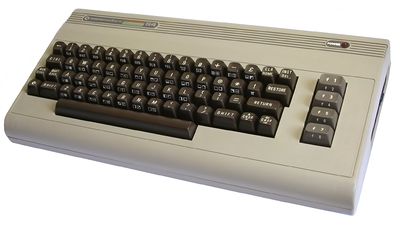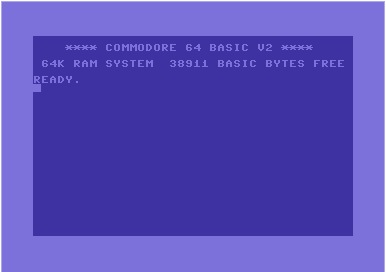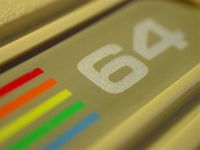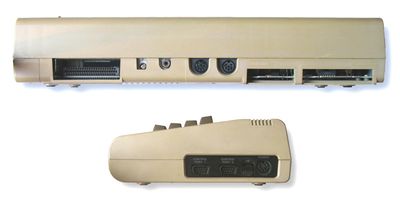C64
| C64 | |
 | |
| Type: | Home Computer |
| Producer: | Commodore |
| Price: | under 600 US$ (equivalent to about 2068 US$ today) |
| Released: | 1982 |
| Discontinued: | 1993 |
| Processor: | MOS 6510/8500 @ ca. 1 MHz |
| Memory: | 64 KByte, upgradeable |
| OS: | BASIC V2.0 |
| Info: | - alias C-64, VIC-64; VIC-64S; VC-64 and CBM-64 - Nicks: 64er or CeVi, classical models bread box or bread bin - differents designs - Forerunner: VIC-20 - Follower: C128/D/DCR |
This is a quick overview of the Commodore 64 home computer. For more details, tricks, and hints see the relevant wiki articles.
In the early 1980s Commodore released the world's first color video home computer, the VIC-20, which quickly sold millions of units across America and Europe. It was so phenomenally successful that when Commodore planned their next model, they decided to keep the VIC's general design and to upgrade the sound, graphics, and memory. They named this new machine, now with 64 kilobytes of memory, the Commodore 64 (alias C64, CBM64, C=64, VIC-64, VC-64 in Germany, VIC=64S in Sweden).
Thanks to its sophisticated audiovisual abilities, its real keyboard, and its range of cheap add-on hardware, the C64 sold even better than its predecessor. That success quickly led to software houses releasing hundreds of cheap, high-quality programs and video games for the C64, which in turn increased the machine's popularity. It eventually became the world's highest selling home computer. An international committee of computer magazine journalists twice voted it "computer of the year."
Three years later, Commodore released the C64's successor, the C128, which doubled as an office computer. However, the C64 continued to sell well. The fall of the Berlin Wall in 1989 prolonged its shelf life again, with Commodore shipping millions more units in Eastern Europe.
The C64 continued to sell until 1993 – 13 years after its introduction – when Commodore collapsed due to financial difficulties. Overall sales figures for the Commodore 64 vary. Some commentators estimate the number of units sold at 30 million, but a more likely figure is 17 million (with 3 million sold in Germany). Forty years after its release, the Commodore 64 is still the most popular home computer of all time.
Characteristics[edit | edit source]


The C64 enjoyed several advantages over its rivals:
- It could use the whole 16-bit address bus (64 kilobytes).
- It provided advanced sound and graphics features (like sprites, HiRes, and multicolor).
- Existing VIC-20 peripherals could be used (after a little remodeling).
- Older Commodore BASIC programs (up to version 2.0) could be used.
- It could also use the CP/M operating system, though this required a Z80 CPU cartridge (extremely rare!).
- It had other cartridges for programming languages such as Logo and Pascal.
Thanks to these advantages, the computer market quickly adopted the C64, especially in Germany. There, dozens of C64-related books and magazines became available soon after its release. German publishers such as Markt & Technik, Data Becker, and Heise Verlag used their experience from the VIC-20, PET and PC-CBM to create products for the new C64. The most popular C64 magazine in Germany was the 64'er, but these other international home computer magazines might also be of interest:
- Ahoy! (USA)
- Commodore Computing International (England)
- Commodore Force (England)
- Commodore Format (England)
- Commodore Horizons (England)
- commodore power/play (USA, Commodore magazine for computer players by Commodore)
- Commodore World (USA)
- Compute! (USA)
- Compute!'s Gazette (USA)
- Creative Computing (USA)
- Loadstar disk mag (USA, England)
- Retro Gamer (British and German publishers and editons)
- RUN (USA and German Publishers and editons)
- The Transactor, later Commodore INTERFACE, later commodore - the microcomputer magazine, later Commodore Magazine (Kanada, USA, Commodore house magazine started by Commodore)
- VIC-rapport (Sweden)
- Your Computer (Australian and british Publishers and editons)
- Your Commodore (England)
- Zzap!64 (game magazine)
These magazines often had program listings for readers to type in, which gave them cheap access to a wide range of interesting software. Other general computer magazines also joined in the home computer trend, publishing program listings for the C64 and other 8-bit micros: German computer magazines such as MC, CHIP and C'T.
Software on data storage (disk, cassette or cartridge) was a more expensive alternative to printed listings. Specialized 'diskmags,' like the German INPUT 64, Magic Disk 64, Game On or Golden Disk 64, made software and related articles available on a tape or disc that was usually attached to the front cover.
The initial price for the C64 was under US$ 600 (in Germany 1395 DM - today ca. 700 €). Later, Europe saw a huge price reduction. At the end of the 1980s, the price for the first C64 models was about 400 DM (today ca. 200 €). The price for a 1541 unit was around about 500 DM (today ca. 250 €).[1][2]
Construction[edit | edit source]
-
C64 - C64 without the keyboard.
-
C64 - Motherboard 1982.
-
C64 - Motherboard 1992.
Commodore often recycled designs from earlier computers. For example, the prototype of the C64 had the same case as its predecessor, the VIC-20 (which looked like a brown breadbox with black keys and brighter function keys). The first production run of the C64 also differed in case and keyboard colors from later models. The following variants were brighter, flatter, or more modern looking, though the concept of a home computer with a keyboard stayed the same (with exceptions like the SX-64 and C64 Game System). The ports and interfaces are listed with ‘I’ for data input and ‘O’ for output:

Side Panel[edit | edit source]
- Two gameports (Controlports, 9-pins, i) to connect a joystick, lightpen, mouse or a few paddles
- Power Switch
- Power Connector (Power; 7-pins) to connect for the power supply (4-pins)

Rear[edit | edit source]
- Expansion port (44-pins; i/o) to connect cartridges
- TV-connector (HF-Modulator-Output; o) to connect a television (in the versions NTSC or PAL)
- Audio-/Video (5-pins; o) to connect a monitor or a stereo
- Serial Bus (IEEE-488, 6-pins, i/o) to connect a diskdrive 1541/70/71/81 or printer MPS-801/802/803, VIC-1515/1525/1526
- Cassette Connector (Cassette port 12-pins; i/o) to connect a cassette recorder (Datasette) 1530 or CN2
- Userport (RS-232 or Centronics; 24-pins; i/o) to connect cartridges, reset button or modems.
Mainboard[edit | edit source]
- CPU: MOS 6510 or 8500 ~ 1 MHz
- Memory: 64 KByte RAM, with 38911 bytes free usable under BASIC
- ROM: 20 KByte, divided into:
- Graphic: VIC-II
- NTSC-version: 6566/6567/8562
- PAL-version: 6569/8565
- Screen modes: Text mode (big/graphic letters or big/small letters) 40 (rows) * 25 (columns) chars or in graphic mode (HiRes) 320*200 pixel in 16 colours, 16 border-colour and 16 background-colour (colour) or multicolor (4 colours) 160*200 pixel, 8 sprites (HiRes or multicolor) in BASIC
- Sound: SID 6581/8580 are used for sound generation with 3 independent voices over 8 octaves (~96 notes) or noises with filter.
- Keyboard: 66 keys (QWERTY), with multiple chars
- Others: 2 interface-chips CIA-6526 for I/O-control
Technical Details[edit | edit source]
For the all technicals details see also the article Hardware Assembly of the C64.
CPU : 6510 @ 0.9852486MHz (PAL)
1.0227273MHz (NTSC)
RAM : 64 Kb DRAM
.5 Kb SRAM (colour RAM $d800-dbff)
ROM : 20kB ROM together, in 3 ROMs :
- 8k BASIC V2 ($a000-bfff)
- 8k Kernal ($e000-ffff)
- 4k Character ROM ($d000-dfff)
(In new versions BASIC and Kernal are together in a 16 Kb-ROM)
Graphic : VIC-II ($d000-d3ff)
Sound : SID ($d400-d7ff)
Interfaces : User port
Expansion port
Audio/Video connector
Cassette interface
Game port (2x)
Serial IEC-Port
TV Connector
Keyboard : 66 Keys (included Graphic Letters)
Power Supply : Extern (9V AC, +5V DC)
Accessories[edit | edit source]
The C64 supports a wide range of devices:
Input: mouse, joystick, lightpen or paddles
Drives: Commodore cassette driver ("Datassette" 1530 / CN2), disk drives (1541/70/71/81), hard disks
Peripherals: modem, printer, cartridges
Commodore went bankrupt in 1994, but the C64 scene remains active. Many contemporary projects use modern technology with C64s. For example: IDE hard disks and CD/DVD-drives, memory cards, MP3-files, and the internet.
Variants[edit | edit source]
Commodore manufactured the C64 for about 10 years. During that period, the case and keyboard varied in color (white, brown, etc.) and shape (breadbox or v-formation). Commodore also introduced newer C64 variations, like the MAX Machine, PET64, SX-64, and C64 GS.
- 1982 in USA, 1983 in Germany: C64-Prototype: grey bread box with black keys (until 1984)
(Silver Label[3]):)- lined with plastic (convex form)
- metallic (e.g.. export and US models)
- paper (very rare, for example units with three digit serial numbers)
- 1982: Commodore MAX Machine (VC-10): Slimming version of the C64 like a game computer (or a video game console) only sold in Japan.
- 1982: PET64: alias the Educator 64 is a special model for schools with integrated monitor than first educational computer.
- 1983: SX-64, also DX64 and SX100: A portable C64 with integrated disk drive and monitor.
- 1984 in USA, 1986 in Germany: Golden C64 series
- A limited edition of the C64 with gold-colored keyboard box. - 1986: C64C or C64-II: Gray colored, flat design, which looks like the C128 (keyboard version).
- 1987: C64-Aldi: A special german version of a low cost C64, which was selling in German famous supermarket called ALDI.
- 1988: C64G: Low cost C64 with newer board and light gray case.
- 1988: C64C CR: Low cost C64C, plastic clips instead of screwed together.
- 1990: C64 Games System (C64 GS): Constricted version (without keyboard and lower interfaces) of C64 like a game console (1990).
Using[edit | edit source]
After power up, the C64 starts in Commodore BASIC 2.0. Users can type in their own programs, store and retrieve them using disks or tapes, and print them on the printer. This BASIC system can be extended using cartridges. Cartridges also make it possible to run other programming languages, such as Pascal or Forth, and other operating systems, such as CP/M. Another advantage of cartridges is that, unlike disks and tapes, they load instantly.
Compatibility between VIC-20, C64 and C128[edit | edit source]
The VIC-20, C64 and C128 all use BASIC 2.0, so BASIC programs will transfer between them.
- Some pre-BASIC 2.0 programs from the PET or PC-CBM (3000/4000/8000) will run on the C64.
- C64 programs can be made to run on a PET/CBM computer by running this command:
POKE 40,1: POKE 41,8: POKE 8*256,0: NEW - The C128 can operate in ‘C64 mode,’ making C64 software almost 100% compatible.
However, there are some portability issues:
- The memory maps differ between models, meaning that programs with PEEK, POKE, SYS and USR are not entirely transferable.
- Memory sizes differ. The VIC-20 has 5 kilobytes of memory (3.583 bytes RAM free in BASIC), which is far less than the C64’s 64 kilobytes (38.911 bytes in BASIC). And it lacks sprites. These differences mean that only simple and short BASIC programs will transfer between the C64 and VIC-20.
- While the C128 has about 128 kilobytes of memory and the more sophisticated BASIC 7.0, making it easier to transfer programs, software written in BASIC above version 2.0 cannot be used on the C64 without software upgrades or cartridges.
Links[edit | edit source]
| Wikipedia: C64 |
- The C64 timeline at pctimeline.info
- Commodore 64 at 8Bit-Museum

- Commodore 64 at CBM-Museum Kuto

- C64 models at C64-Online

- VIC=64S Broschüre

- VIC=64S Zubehörbroschüre

Videos[edit | edit source]
- Video at YouTube C64 TV advertise 1982
- Video at YouTube C64 TV advertise 1982
- Video at YouTube C64 TV advertise as learning computer 1982
- Video at YouTube Australian C64 TV advertise 1983
- Video at YouTube C64 TV advertise 1983
- Video at YouTube C64 TV advertise 1985
- Video at YouTube C64 TV advertise 1982
- Video at YouTube C64 TV advertise 1982
- Video at YouTube C64 TV advertise 1985
- Video at YouTube "Commodore C64 - 1982", Introducion with Jim Butterfield (2:07 Std.)

